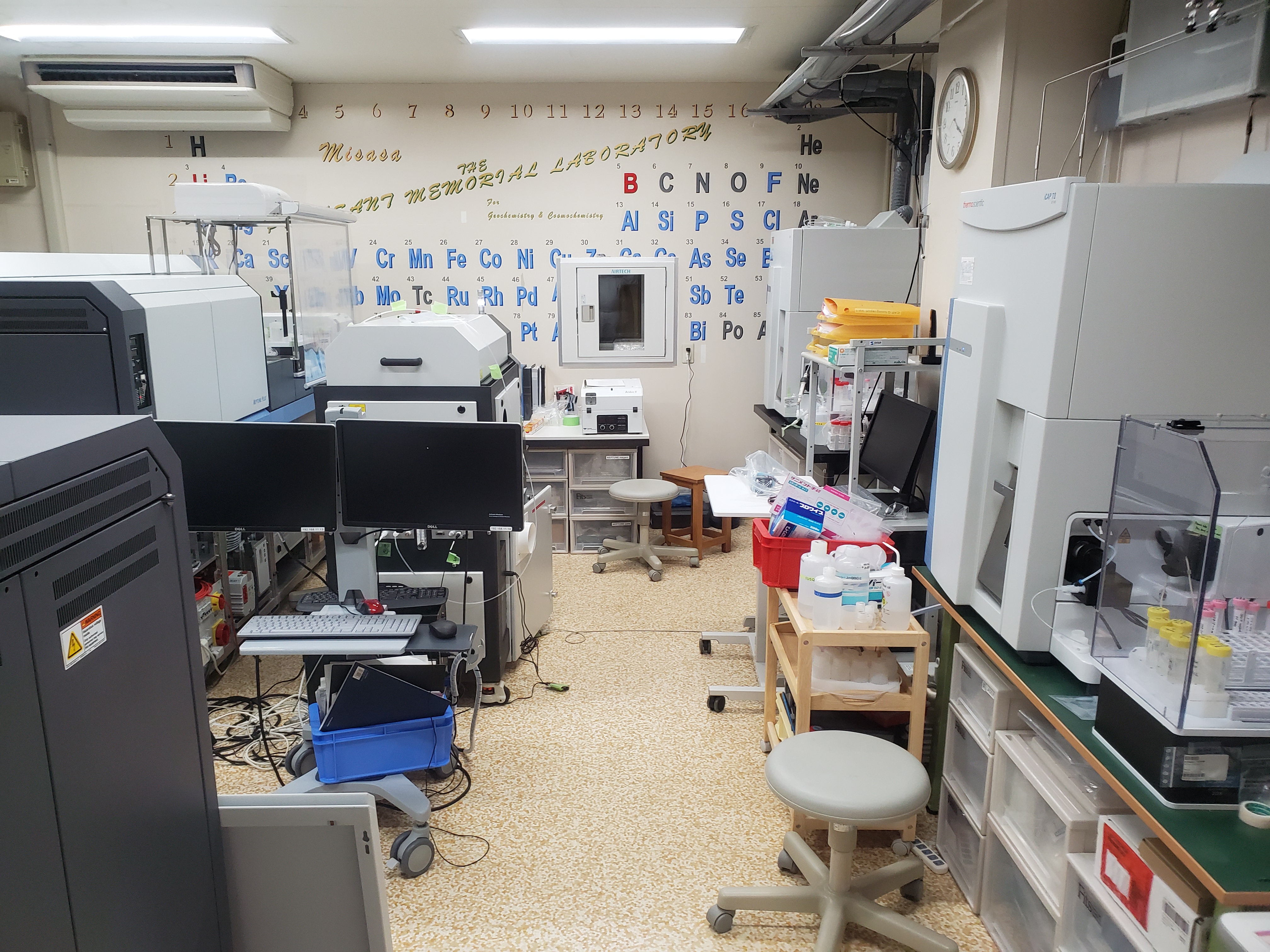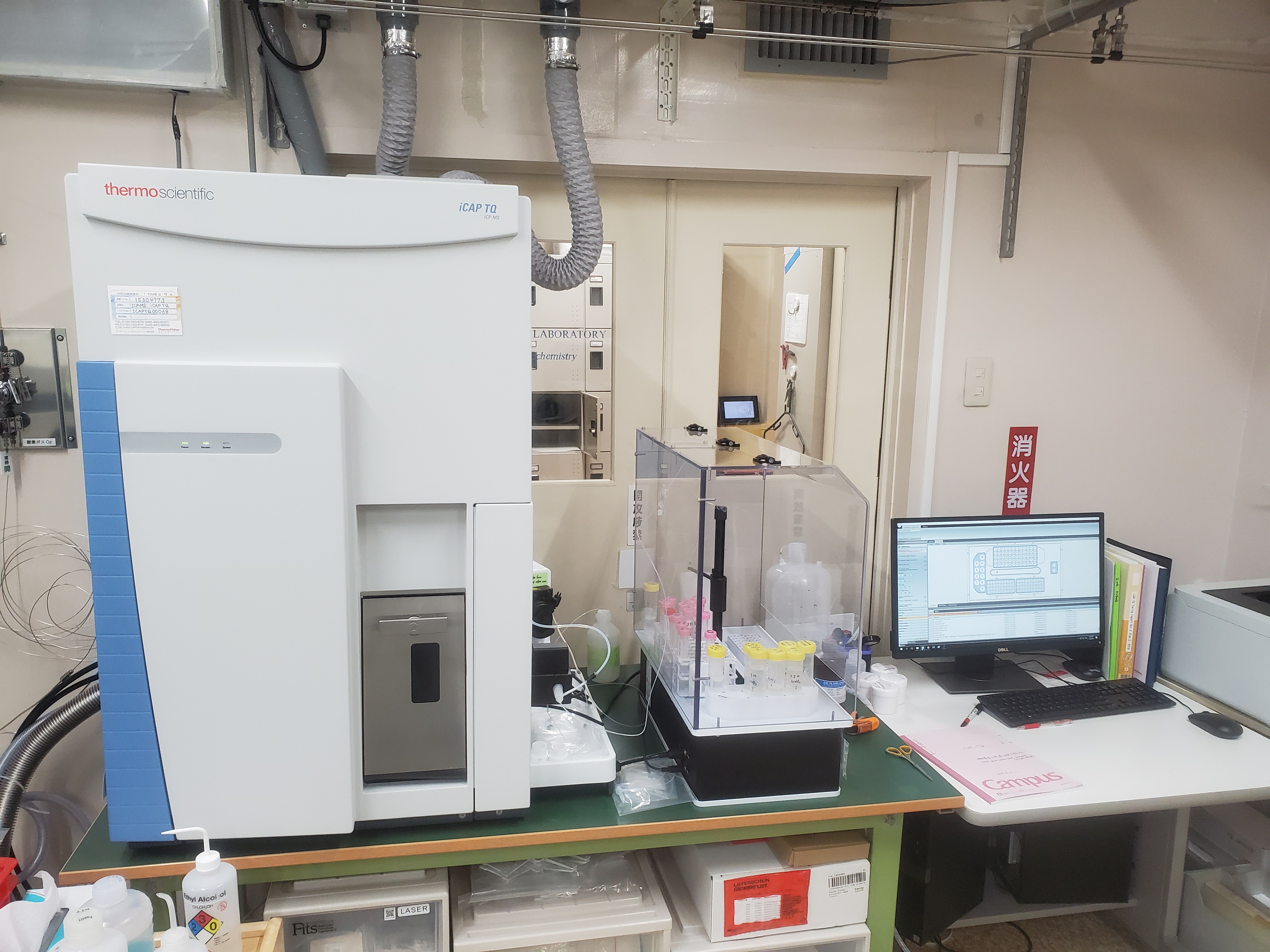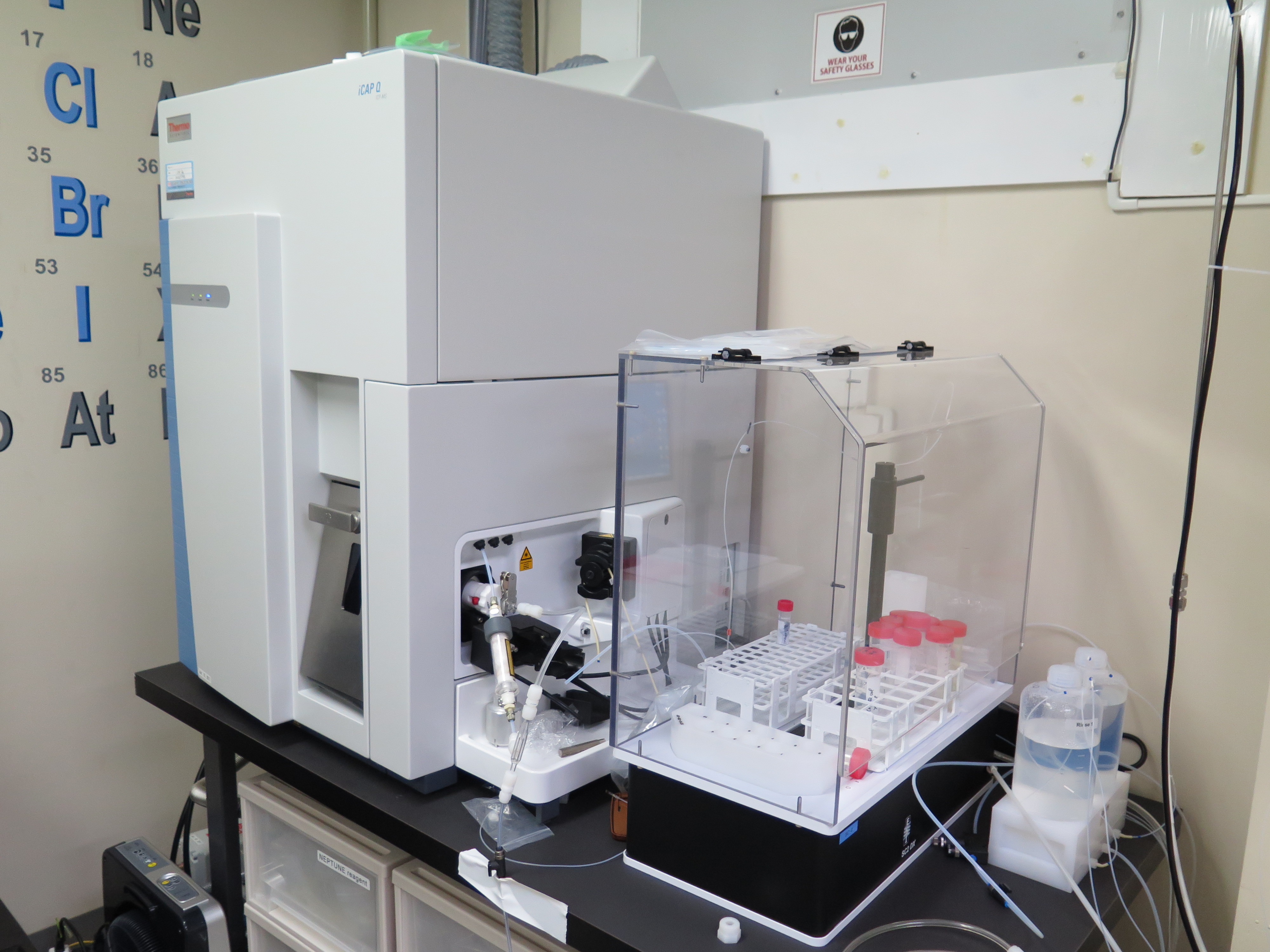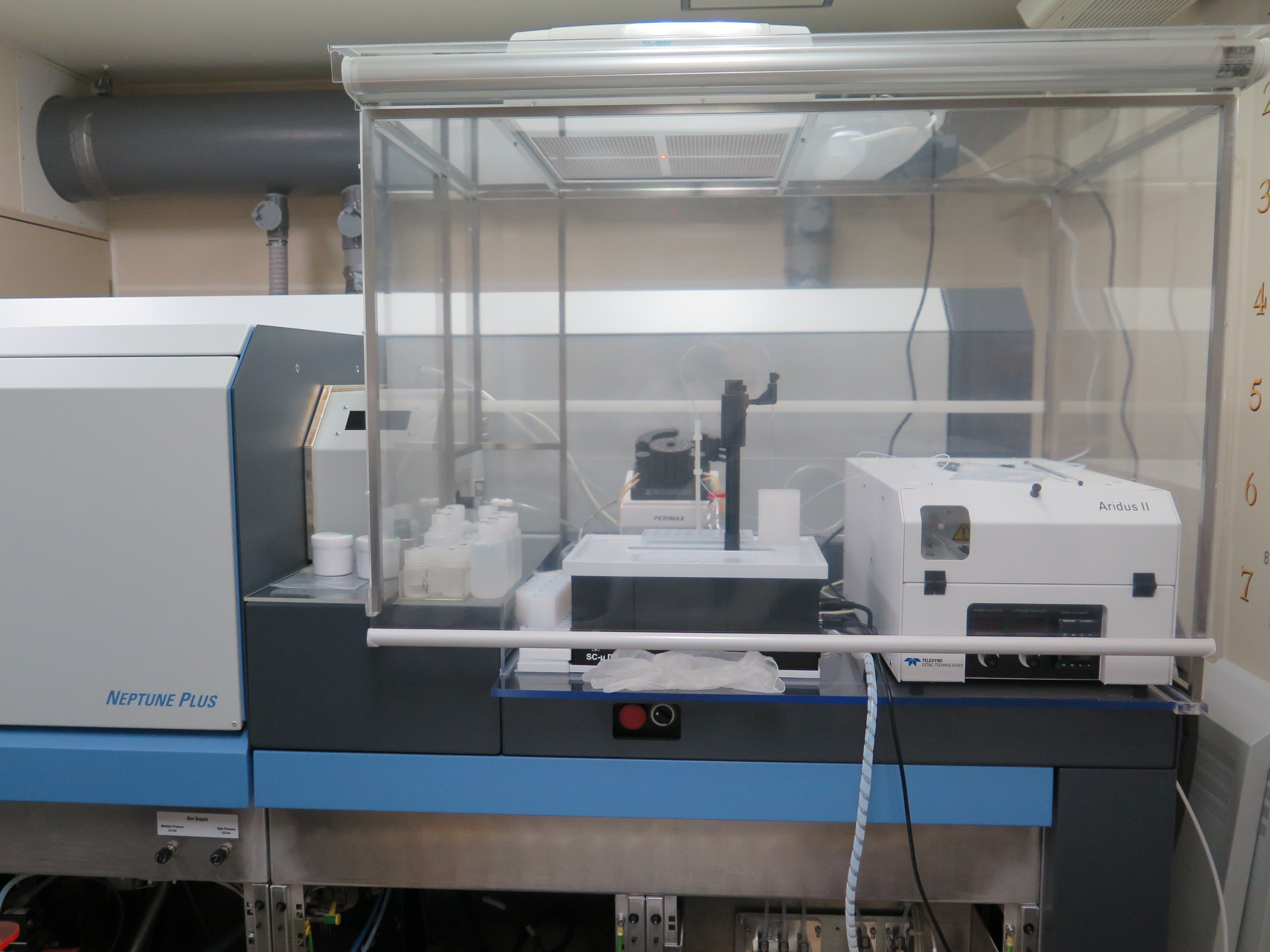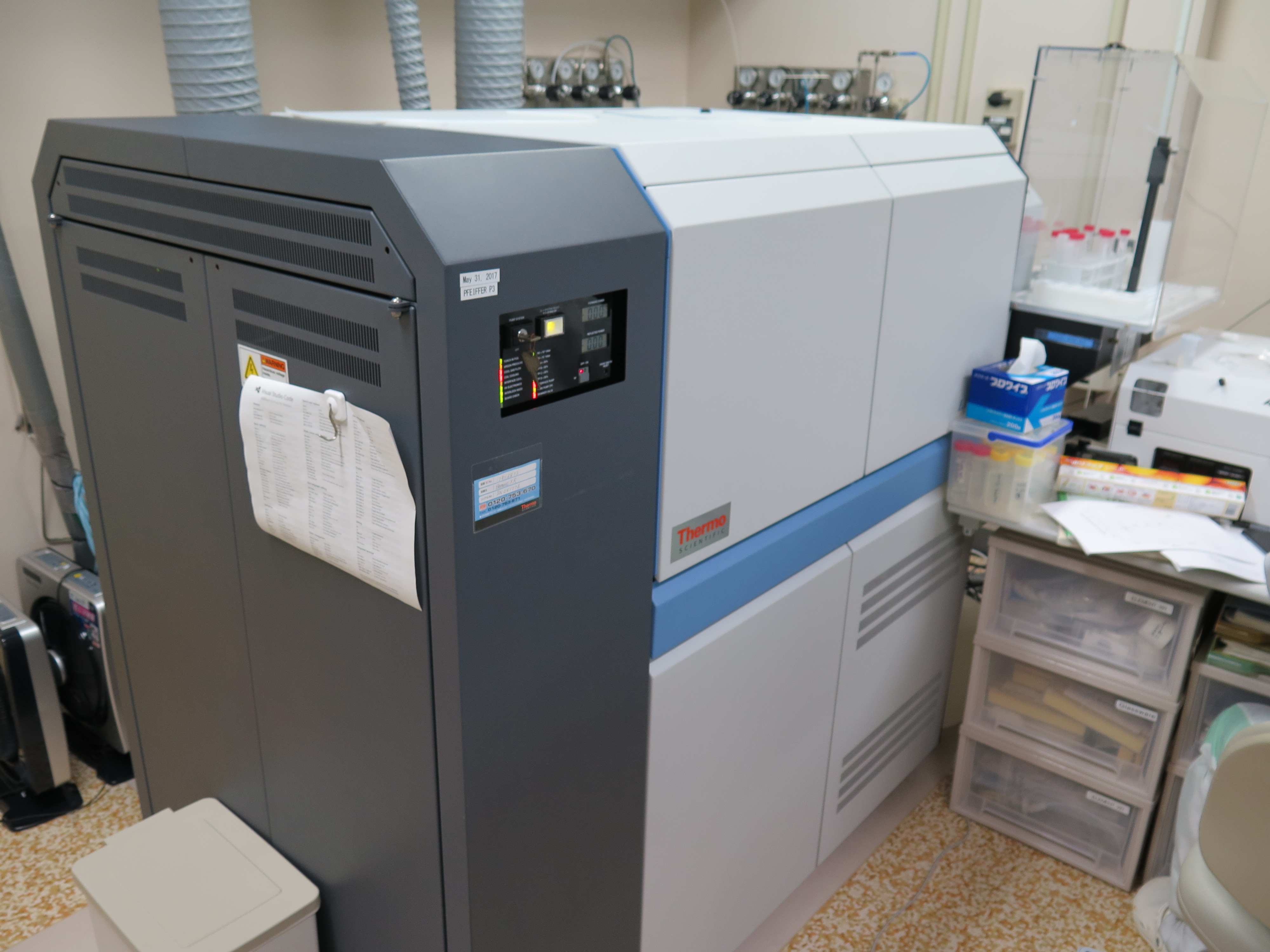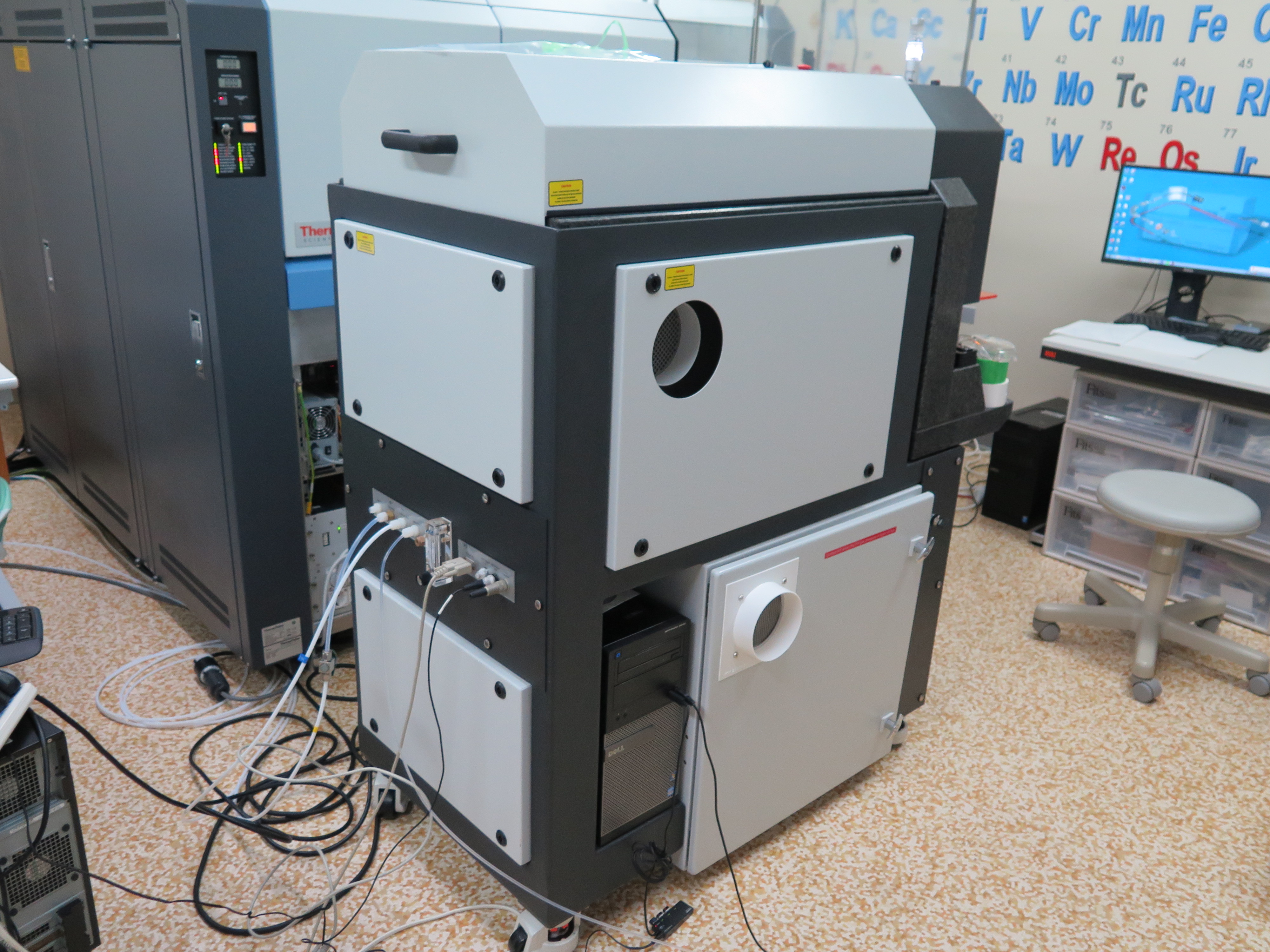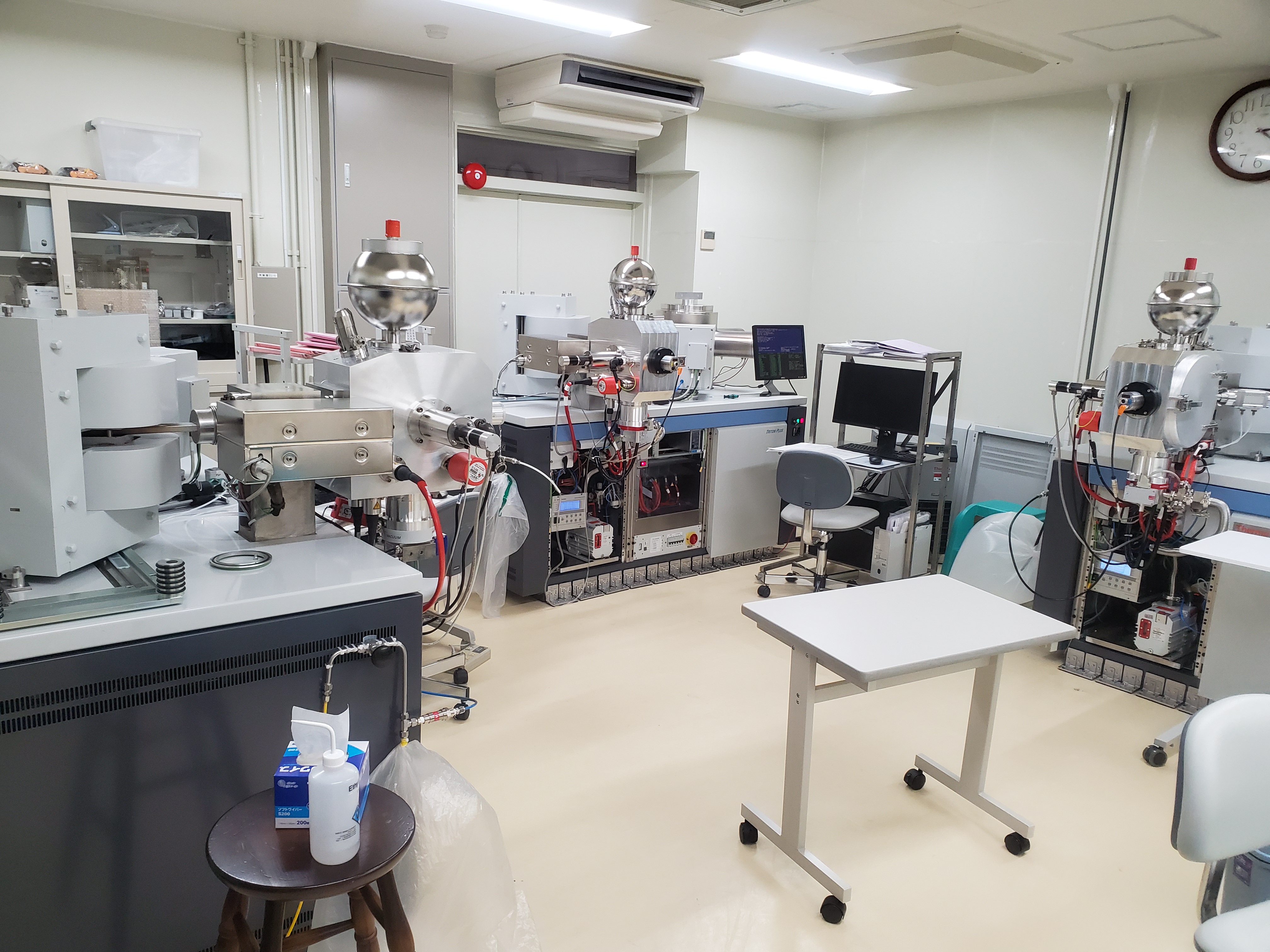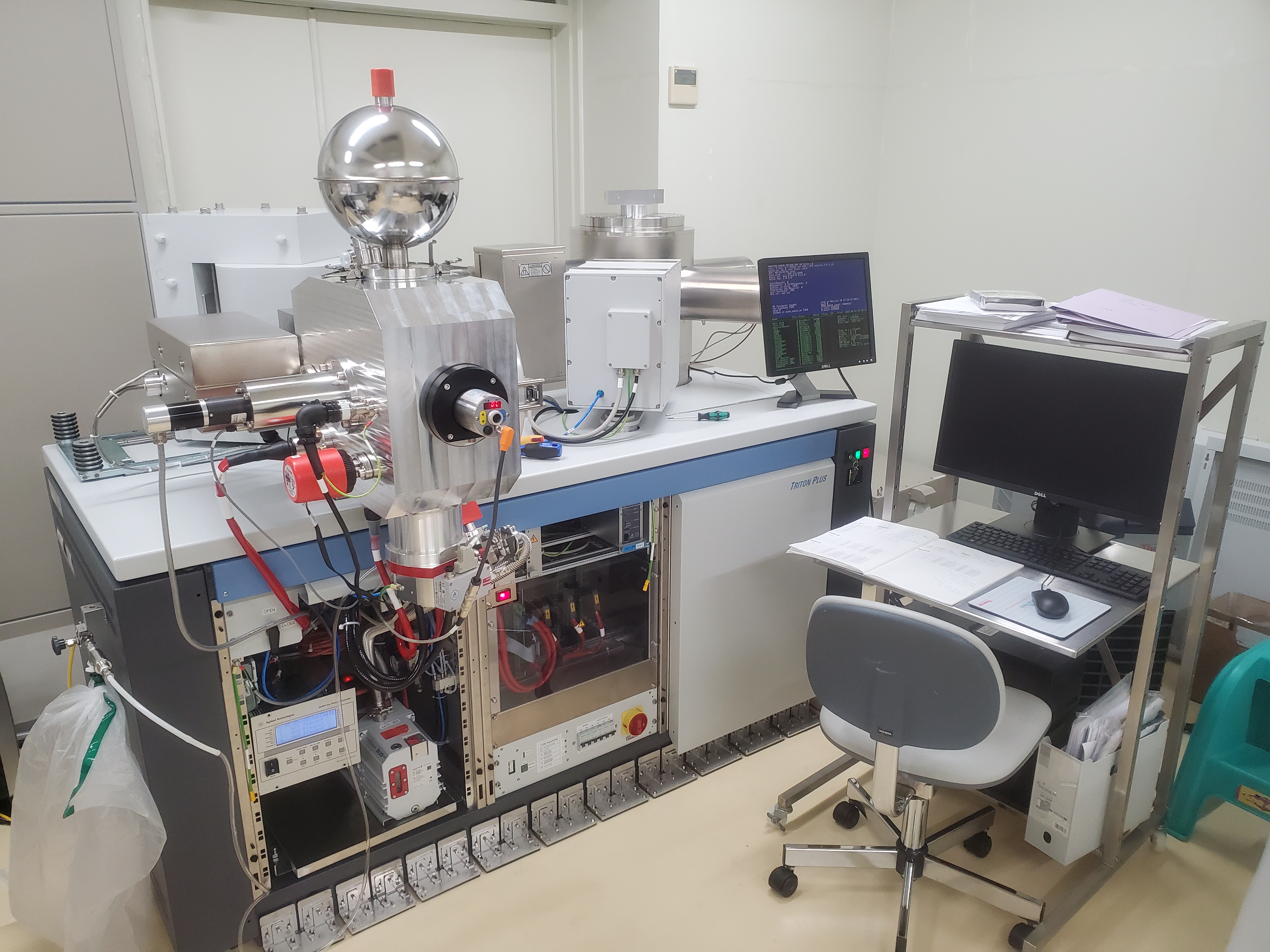Instrumentation lab
Instrumentation lab includes ICP-MS room and TIMS room
ICP-MS room
NEPTUNE PLUS (Thermo Scientific)
Introduced in November 2017. Equipped with nine Faraday cups and eight CDD detectors. Li, Hf isotope analyses, Ra quantitative analysis are carried out. We are currently preparing for isotopic analysis of Si, Fe and Ni, etc.- Methods and techniques:
- A. Makishima (2013) A Simple and Fast Separation Method of Fe Employing Extraction Resin for Isotope Ratio Determination by Multicollector ICP-MS, International Journal of Analytical Mass Spectrometry and Chromatography, 1(2), 95-102
- A. Makishima and E. Nakamura (2013) Low-blank chemistry for Zn stable isotope ratio determination using extraction chromatographic resin and double spike-multiple collector-ICP-MS, Journal of Analytical Atomic Spectrometry, 28, 127-133
- A. Makishima and E. Nakamura (2012) High-resolution MC-ICPMS employing amplifers with a 1012ohm resistor for bulk sulfur determination in biological and geological samples, Journal of Analytical Atomic Spectrometry, 27, 891-895
- Makishima et al. (2010) Precise determination of Cr, Mn, Fe, Co and Ni concentration by an isotope dilution-internal standardization method employing high resolution MC-ICP-MS, Chemical Geology, 274(1-2), 82-86
- A. Makishima and E. Nakamura (2010) Precise isotopic determination of Hf and Pb at sub-nano gram levels by MC-ICP-MS employing a newly designed sample cone and a pre-amplifier with a 1012 ohm register, Journal of Analytical Atomic Spectrometry, 25, 1712-1716.
- Makishima et al. (2008) Precise measurement of 228Ra/226Ra for 226Ra determination employing total integration and simultaneous 228Th correction by multicollector ICP-MS using multiple ion counters, Journal of Analytical and Atomic Spectrometry, 23, 1102-1107.
- A. Makishima and E. Nakamura (2006) Determination of Os and Re Isotope Ratios at Subpicogam Levels Using MC-ICPMS with Solution Nebulization and Multiple Ion Counting, Analytical Chemistry, 78(11), 3794-3799.
- Moriguti et al. (2004) Determination of Lithium Contents in silicates by Isotope Dilution ICP-MS and Its Evaluation by Isotope Dilution Thermal Ionisation Mass Spectrometry, Geostandars and geoanalytical research, 28(3), 371-382.
ELEMENT XR (Thermo Scientific)
Sector type ICP-MS. 18 element concentration + PGE concentration determination can be performed. The sample is decomposed with three different decomposition methods and measured by three different analytical sequences. The minimum necessary amount of sample to be solution for analysis is ~10 mg in case of basaltic rocks.- Methods and techniques:
- Zhou et al. (2019) A Method to Suppress Isobaric and Polyatomic Interferences for Measurements of Highly Siderophile Elements in Desilicified Geological Samples, Geostandards and Geoanalytical Research, 43(4), 611-633.
- A.Makishima (2014). Cu Purification Using an Extraction Resin for Determination of Isotope Ratios by Multicollector ICP-MS, Chromatography, 1(3), 96-107
- A. Makishima and E. Nakamura (2006). Determination of major, minor and trace elements in silicate samples by ICP-QMS and ICP-SFMS applying isotope dilution-internal standardisation (ID-IS) and multi-stage internal standardisation, Geostandards and Geoanalytical Research, 30(3), 245-271.
- Makishima et al. (2002) Determination of chromium, nickel, copper and zinc in milligram samples of geological materials ushig isotope dilution high resolution inductively coupled plasma-mass spectrometry, Geostandards Newsletter, 26(1), 41-51.
- A. Makishima and E. Nakamura (2001). Determination of total sulfur at microgram per gram levels in geological materials by oxidation of sulfur into sulfate with in situ generation of bromine using isotope dilution high resolution ICPMS, Analytical Chemistry, 73(11), 2547–2553.
- A. Makishima and E. Nakamura (2000). Determination of titanium at µg g-1 levels in milligramamounts of silicate materials by isotope dilution highresolution inductively coupled plasma mass spectrometry with flow injection, Journal of Analytical Atomic Spectrometry, 15(3), 263-267.
iCAP TQ ICP-MS (Thermo Scientific)
ICP - QMS. It is possible to analyze the concentration of 36 elements (Li, Be, B, Rb, Sr, Y, Zr, Nb, Mo, Cd, In, Sn, Sb, Cs, Ba, REE [La, Ce, Pr, Nd, Sm, Eu, Gd, Tb, Dy, Ho, Er, Tm, Yb, Lu] Hf, Ta, Tl, Pb, Bi, Th and U) using samples of two different decomposition methods (total of 3 sequences). The minimum necessary amount of sample for analysis is about 2 mg in the case of Basaltic rocks.- Methods and techniques:
- Makishima et al. (2011) Simultaneous Determination of Cd, In, Tl and Bi by Isotope Dilution‐Internal Standardisation ICP‐QMS with Corrections Using Externally Measured MoO+/Mo+ Ratios Geostandards and Geoanalytical Research, 35(1), 57-67.
- A. Makishima and E. Nakamura (2009). Determination of Ge, As, Se and Te in Silicate Samples Using lsotope Dilution-Internal Standardisation Octopole Reaction Cell ICP-QMS by Normal Sample Nebulisation, Geostandards and Geoanalytical Research, 33(3), 369-384.
- A. Makishima and E. Nakamura (2006). Determination of major, minor and trace elements in silicate samples by ICP-QMS and ICP-SFMS applying isotope dilution-internal standardisation (ID-IS) and multi-stage internal standardisation, Geostandards and Geoanalytical Research, 30(3), 245-271.
- Moriguti et al. (2004) Determination of Lithium Contents in silicates by Isotope Dilution ICP-MS and Its Evaluation by Isotope Dilution Thermal Ionisation Mass Spectrometry, Geostandars and geoanalytical research, 28(3), 371-382.
- A. Makishima and E. Nakamura (1999). Determination of molybdenum, antimony and tungsten at sub µg g-1 levels in geological materials by ID-FI-ICP-MS, Geostandards Newsletter, 23(2), 137-148.
- Makishima et al. (1999) Determination of zirconium, niobium, hafnium and tantalum at ng g-1 levels in geological materials by direct nebulisation of sample HF solution into FI-ICP-MS, Geostandards Newsletter, 23(1), 7-20.
iCAP-Qs (Thermo Scientific)
ICP- QMS. Perform in situ spot quantitative analysis of the polished specimen combined with laser equipment. U - Pb dating of Zircon, and trace element analysis such as REE are proceeded.
Analyte G2 Excimer Laser system (Teledyne)
Ar-F Excimer laser system. The wavelength is 193 nm. The system is used for in-situ spot analysis combined with ICP-MS (LA-ICP-MS). Currently, it is mainly connected with iCAP-Qs, for U-Pb dating of zircon, trace element analysis such as REE etc. are examined. According to the linkage to the Visual Stage system (see more info), it is easily set the analytical position precisely under the laser system while confirming the images and data obtained by the microscope, SEM and ion-probes. We have a plan that this equipment will be proceeding connect with Neptune plus and/or Element XR for the in situ spot analysis for much wider applications.ICP-MS labSpherical Image - RICOH THETA
Technical Utilities
- NEPTUNE PLUS (Thermo Scientific)
- Element XR (Thermo Scientific)
- iCAP TQ ICP-MS (Thermo Scientific)
- iCAP-Qs (Thermo Scientific)
- Analyte G2 Excimer Laser system (Teledyne)
Analytical Capabilities
- 54(+more) element concentration determination
- Li, Hf isotope analysis
- Lu-Hf systematics
- U-Pb age dating
Related Work
- Li et al. (2020) Various Ages of Recycled Materialin the Source of Cenozoic Basalts in Southeast China: Implications for the Role of the Hainan Plume, Journal of Petrology, egaa060.
- Hoang et al. (2019). Determination of abundances of fifty-two elements in natural waters by ICP-MS with freeze-drying pre-concentration, Geostandards and Geoanalytical Research, 43(1), 147-161.
- Belay et al. (2019) Origin of ocean island basalts in the West African passive margin without mantle plume involvement, Nature Communications, 10, 3022.
- Pineda-Velasco et al. (2018) Production of High-Sr Andesite and Dacite Magmas by Melting of Subducting Oceaninc Lithosphere at Propagating Slab Tears, Journal of Geophysical Research: Solid Earth, 123(5), 3698-3728.
- Tikhomirov et al. (2016) Trace element and isotopic geochemistry of Cretaceous magmatism in NE Asia: Spatial zonation, temporal evolution, and tectonic controls, Lithos, 264(1), 453-471.
- Tanaka et al. (2015) Evaluation of the applicatbility of acid leaching for the 238U-230Th internal isochron method, Chemical Geology, 396, 255-264.
- Feineman et al. (2013) Sediment-enriched adakitic magmas from the Daisen volcanic field, Southwest Japan, Geochemistry, Geophysics, Geosystems, 14(8), 3009-3031.
- Nakamura et al. (2012) Establishment of comprehensive analytical system for terrestrial and extraterrestrial Materials behind the initial analysis of particles returned by Hayabusa spacecraft, Journal of the Surface Science Society of Japan, 33(12), 681-686.
- Kuritani et al. (2011) Geochemical evolution of historical lavas from Askja Volcano, Iceland: Implications for mechanisms and timescales of magmatic differentiation, Geochimica et Cosmochimica Acta, 75(2), 570-587.
- Marín-Cerón et al. (2010) Slab decarbonation and CO2 recycling in the Southwestern Colombian volcanic arc, Geochimica et Cosmochimica Acta, 74(3), 1104-1121.
- Nath et al. (2009) Comprehensive analysis for major, minor and trace element contents and Sr-Nd-Pb-Hf isotope ratios in sediment reference materials, JSd-1 and MAG-1, Geochemical Journal, 43, 207-216.
- Kitagawa et al. (2008) Multiple Pulses of the Mantle Plume: Evidence from Tertiary Icelandic Lavas, Journal of Petrology, 49(7), 1365-1396.
- Ishikawa et al. (2007) Ancient recycled crust beneath the Ontong Java Plateau: Isotopic evidence form the garnet clinopyroxenite xenoliths, Malaita, Solomon Islands, Earth and Planetary Science Letters, 259(1-2), 134-148.
- Shimizu et al. (2005) The Geochemistry of Ultramafic to Mafic Volcanics from the Belingwe Greenstone Belt, Zimbabwe: Magmatism in an Archean Continental Large Igneous Province, Journal of Petrology, 46(11), 2367-2394.
- K. Kobayashi and E. Nakamura (2001) Geochemical evolution of Akagi Volcano, NE Japan: implications for interaction between island-arc magma and lower crust, and generation of isotopically various magmas, Journal of Petrology, 42(12), 2303-2331.
- M. Yoshikawa and E. Nakamura (2000) Geochemical evolution of the Horoman peridotite complex:Implications for melt extraction, metasomatism, andcompositional layering in the mantle, Journal of Geophysical Research, 105(B2), 2879-2901.
TIMS Room
TRITON PLUS (Thermo Scientific)
Introduced in November 2017. Equipped with nine Faraday cups and eight CDD detectors. Three of 10^13, 4 of 10^12 and 3 of 10^11 amplifiers are implementation. The preparation of Os isotope analysis and ultra-trace sample analysis are in progress.- Methods and techniques:
- T. Yokoyama and E. Nakamura (2004) Precise analysis of the 228Ra/226Ra isotope ratio for short-lived U-series disequilibria in natural samples by total evaporation thermal ionization mass spectrometry (TE-TIMS), Journal of Analytical Atomic Spectrometry, 19(6), 717-727.
- T. Kuritani and E. Nakamura (2003). Highly precise and accurate isotopic analysis of small amounts of Pb using 205Pb-204Pb and 207Pb-204Pb, two double spikes, Journal of Analytical and Atomic Spectrometry, 18(12), 1464-1470.
- T. Kuritani and E. Nakamura (2002) Precise isotope analysis of nanogram-level Pb for natural rock samples without use of double spikes, Chemical Geology, 186(1-2), 31-43.
- Yokoyama et al. (2001) Precise analysis of 234U/238U ratio using UO2+ ion with thermal ionization mass spectrometry for natural samples, Chemical Geology, 181(1-4), 1-12.
- T. Moriguti and E. Nakamura (1998) High-yield lithium separation and the precise isotopic analysis for natural rock and aqueous samples, Chemical Geology, 145(1-2), 91-104.
- M. Yoshikawa and E. Nakamura (1993). Precise isotope determination of trace amounts of Sr in magnesium-rich samples, Journal of Mineralogy, Petrology and Economic Geology, 88(12), 548-561 (in Japanese).
TRITON (Thermo Scientific)
Equipped with nine Faraday cups. Sr, Nd, Pb, B, Os isotope analyses are performed. The MIC system were seriously damaged and could not be maintained due to the earthquake in October 2016.TIMS lab Spherical Image - RICOH THETA
Technical Utilities
- TRITON PLUS (Thermo Scientific)
- TRITON PLUS (Thermo Scientific)
- TRITON (Thermo Scientific)
Analytical Capabilities
- Sr, Nd, Pb, B and Os isotope analysis
- Rb, Sr, Sm, Nd, Pb and B concentration determination by Isotope dilution
- Rb-Sr, Sm-Nd and Pb-Pb systematics and age dating
- Re-Os systematics
Related Work
- Chekol et al. (2011) Timescales of magma differentiation from basalt to andesite beneath Hekla Volcano, Iceland: constraints from U-series disequilibria in lavas from the last quarter-millennium flows, Geochimica et Cosmochimica Acta, 75(1), 256-283.
- Yamakawa et al. (2009) Chemical Separation and Mass Spectrometry of Cr, Fe, Ni, Zn, and Cu in Terrestrial and Extraterrestrial Materials Using Thermal Ionization Mass Spectrometry, Analytical Chemistry, 81(23), 9787–9794.
- Aka et al. (2008) U-series dating of Lake Nyos maar basalts, Cameroon (West Africa): Implications for potential hazards on the Lake Nyos dam, Journal of Volcanology and Geothermal Research, 176(2), 212-224.
